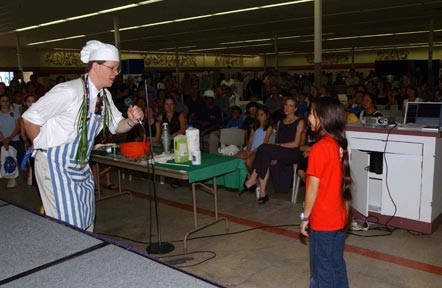Dr. Timothy Livengood, a planetary scientist at the National Center for Earth and Space Science Education, holds court at a family program at the Prince Kuhio Mall, in Hilo, Hawai’i, Sunday, January 2005. Dr. Tim (or should we say Chef Tim) was one of five Visiting Researchers that visited with 5,500 grade K-12 students, conducting 105 presentations across 17 schools. They also conducted 4 Family and Public Programs.
Why is he dressed like that? He’s just been talking about the big rocks and snowballs whizzing around the Solar System—the asteroids and comets, and decided to cook one up. He first had the audience tell him about atoms. Then they learned together that the most plentiful atoms in the Universe—making up almost 100% of the Universe—are hydrogen and helium. Everything else that the audience could name as flavors of atoms—the iron holding up the building, the oxygen they breathe, the copper pennies in their pockets—are just Universal debris. The audience then guessed correctly (they don’t always) that the most plentiful atoms in the debris are carbon, nitrogen, and oxygen. Now if you let these particular atoms and the hydrogen get together socially—we call that chemistry—they form ‘molecules’ of water, carbon dioxide, carbon monoxide, ammonia, and methane. All these when really cold form ices. And if you take a big bowl full of them, say a bowl half a mile across, mix it all up, and throw in some rock, you’ve built a comet. In the photo, Chef Dr. Tim has asked a young lady in the audience to help him cook up a comet in his much smaller bowl, so together they’re making a pretty good model of a comet. Once ‘cooked’, and the comet is placed on an overhead projector that reveals the gases swirling off its icy surface, the audience goes wild. Pretty cool (no pun intended). For a great overview of the power of models—a core tool for all Journey through the Universe programming, visit our sister site dedicated to the Voyage Scale Model Solar System on the National Mall in Washington, DC. |

